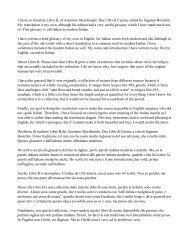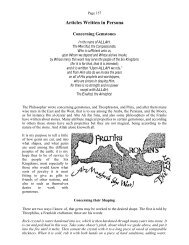How to Milk an Almond Stuff an Egg And Armor a Turnip A ...
How to Milk an Almond Stuff an Egg And Armor a Turnip A ...
How to Milk an Almond Stuff an Egg And Armor a Turnip A ...
Create successful ePaper yourself
Turn your PDF publications into a flip-book with our unique Google optimized e-Paper software.
ingredient in brackets. This me<strong>an</strong>s either that<br />
it is described as optional in the original or<br />
that it is something, usually salt, that is not<br />
mentioned in the original but that we think<br />
should have been—one of our sources says<br />
that he doesn’t mention salt because everyone<br />
knows <strong>to</strong> put it in—or, occasionally, that it is<br />
something in the recipe that we were unable<br />
<strong>to</strong> get <strong>an</strong>d so omitted. Which it is should be<br />
clear from context.<br />
In our recipes, spices such as cinnamon or<br />
cloves are ground unless stated not <strong>to</strong> be.<br />
Some of the early English recipes use the<br />
thorn (þ), a letter that is no longer used in<br />
English. It is pronounced “th.”<br />
Pie Crust Recipes<br />
Our only period English recipe for pie<br />
crust is late period (p. 45: “To make short<br />
paest for tarte,” from A Proper Newe Book); it<br />
consists only of a list of ingredients, <strong>an</strong>d we<br />
believe is intended as a f<strong>an</strong>cy rather th<strong>an</strong> plain<br />
pie crust. There is also a Germ<strong>an</strong> recipe in<br />
Sabina Welserin. What we normally use is a<br />
simple modern recipe that contains only<br />
period ingredients <strong>an</strong>d is made partly with<br />
whole wheat flour, on the guess that most<br />
period flour was coarser th<strong>an</strong> ours <strong>an</strong>d that the<br />
finest white flour would probably not have<br />
gone in<strong>to</strong> pie crust. It is:<br />
¾ c white flour ⅓ c salted butter<br />
¼ c whole wheat flour 2 ½ T water<br />
Mix flours, cut butter finely in<strong>to</strong> flour with<br />
two knives or a food processor, then mix the<br />
water in<strong>to</strong> the flour-butter mixture without<br />
crushing the flour <strong>an</strong>d butter <strong>to</strong>gether. Makes<br />
a single 9" crust.<br />
An alternative, for recipes that specify a<br />
crust but do not say what sort, is <strong>to</strong> simply<br />
knead flour <strong>an</strong>d water with a little salt. The<br />
result is much <strong>to</strong>ugher th<strong>an</strong> a pastry crust,<br />
which has both adv<strong>an</strong>tages <strong>an</strong>d disadv<strong>an</strong>tages.<br />
The qu<strong>an</strong>tities for one 9" pie are:<br />
3 c flour about 1 ¼ c water<br />
¼ t salt<br />
7<br />
Sourdough<br />
A number of our recipes use sourdough as<br />
leavening. There are recipes for making your<br />
initial batch of sourdough using wild yeast<br />
from the air, but we have never done it; we<br />
always started with a batch of sourdough from<br />
someone else.<br />
You c<strong>an</strong> keep sourdough in the refrigera<strong>to</strong>r<br />
for quite a long time, but before using it you<br />
will w<strong>an</strong>t <strong>to</strong> spend several days getting the<br />
culture back <strong>to</strong> strength. Start by combining ¼<br />
c sourdough with ½ c water <strong>an</strong>d ½ c flour;<br />
leave it covered at room temperature for 24<br />
hours. Take ¼ c of that, combine with ½ c<br />
water <strong>an</strong>d ½ c flour, leave it covered for 12<br />
hours. Repeat, again for 12 hours. Finally take<br />
½ c of your now pretty lively sourdough,<br />
combine with 1 c water <strong>an</strong>d 1 c flour, leave it<br />
for 6 hours, use it in your recipe. If you are<br />
going <strong>to</strong> require more th<strong>an</strong> that, scale up the<br />
final stage accordingly. Put whatever<br />
sourdough is left in<strong>to</strong> jars <strong>to</strong> give <strong>to</strong> all your<br />
friends so that they c<strong>an</strong> use sourdough in their<br />
cooking <strong>to</strong>o. Or find a good sourdough<br />
p<strong>an</strong>cake recipe <strong>an</strong>d use the rest for that. <strong>And</strong><br />
remember <strong>to</strong> put some sourdough back in<strong>to</strong><br />
the refrigera<strong>to</strong>r.<br />
<strong>Almond</strong> <strong>Milk</strong><br />
<strong>Almond</strong> milk is <strong>an</strong> ingredient common in<br />
Medieval Europe<strong>an</strong> recipes, particularly in<br />
Lenten dishes (milk, eggs, <strong>an</strong>d meat broth all<br />
being forbidden in Lent). The recipe below is<br />
a basic one. For some recipes we make a<br />
thicker almond milk with more almonds<br />
relative <strong>to</strong> the amount of water; other recipes<br />
say “draw up a good milk of almonds with<br />
broth (or wine),” in which case the broth or<br />
wine is substituted for the water in making the<br />
almond milk.<br />
To make almond milk: Take ¼ c (1 ¾ oz)<br />
almonds. Put them in a food processor, run it<br />
briefly. Add a little water, run it longer.<br />
Continue adding water <strong>an</strong>d running the<br />
processor until you have a milky liquid. Strain<br />
through several layers of cheesecloth. Put the<br />
residue back in the food processor, add a little<br />
more water, <strong>an</strong>d repeat. Continue until the





